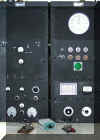The Wireless Set No. 19 Photo Gallery
Page Thirty
Place cursor over thumbnail for details
of photo.
Submit YOUR photos! Please include a short narrative and remember, pictures are
MUCH more attractive if they have a PERSON in them. So, put yourself in FRONT of
the camera, please. If you don't have access to a scanner, you can mail me the
picture, which I will scan and return to you. (Email me for the mailing
address.) However, if you do your own scanning, please keep the finished product
under 2K in size. Thanks much! -Bob.










Chris, VE3CBK, writes regarding Comando Distanza (four photos
above):
"I originally won an eBay auction
back in December 2002 for the "Comando Distanza". It came from
my good friend Eliseo, IK6BAK. Eliseo translated "Comando Distanza"
to mean "Remote Control" in English.
The No 19 was adopted by the Italian Army
from 1944 onwards to the early sixties, according to Louis Meulstee in
Wireless for the Warrior page W.S. 19 (Cdn) - 37. There you can see a
picture of the No 19 and the accessories all referenced in Italian text.
They went so far as to re-stencil the units. The Comando Distanza that
Eliseo sent is actually a re-stencilled Remote Control Unit No 1
(Canadian). I had asked him if he had seen
other parts marked in Italian and he has a MK 2 that was re-stencilled. Mario
IK0MOZ had told me back in 1998 about a PSU made by the Italian
Manufacturer SERTI for the No 19."

VE3BBN reports on his homebrew, above left:
"The left side comprises the Tx . The top most is blank the second down
is the Power / SWR monitoring and switching to put in the 811A 120 watt linear
amp located in the third slot. The fourth slot is the power supply for the
exciter, located in the bottom section. The exciter has a continuous running
Clapp osc, class A amp section then three neg. grid biased amp/doubler
sections. The finals are 2 -807's running a max output of 25 watts. (should
last forever). The receiver cabinet on the right has a clock at the top. The
all band converter covers all bands except 160 & including WARC. The
next chassis is the panoramic adapter for monitoring the activity on both
sides of my signal. It takes the sig from the second IF of 1750 khz and
monitors that. The next is the home of the 2nd and 3rd IF amps, BFO and audio
section. The 1st IF is tunable and is located on the bottom chassis and covers
the freq. range of 3.5 to 3.75 mhz. The usable bandpass is only 80hz out of
the third IF (50khz) and is accomplished by cascading 9 tuned circuits coupled
by only 1pf between each. Needless to say you have to tune slowly or you'll
miss the signal you want, and there is virtually no hiss of background noise
under most condx of receiving except for the odd thunderstorm. The tuning
control on the bottom right covers the 80 meter cw portion of the band and
that requires 50 revolutions of the handwheel for a sliderule of 50 feet
length. The Rx has in its entirety 45 old metal octal tubes and the Tx chassis
has only 8 tubes by comparison. I am extremely pleased with the Rx
and it is a joy to use."





More Photos When YOU Send in YOURS!
This page was generated by MS Front Page
Copyright © R. D. (Bob) Cooke, VE3BDB (Orillia, ON
CA). All Rights Reserved. Nothing on this page may be copied or distributed
without written permission. Thanks for honouring this request.




